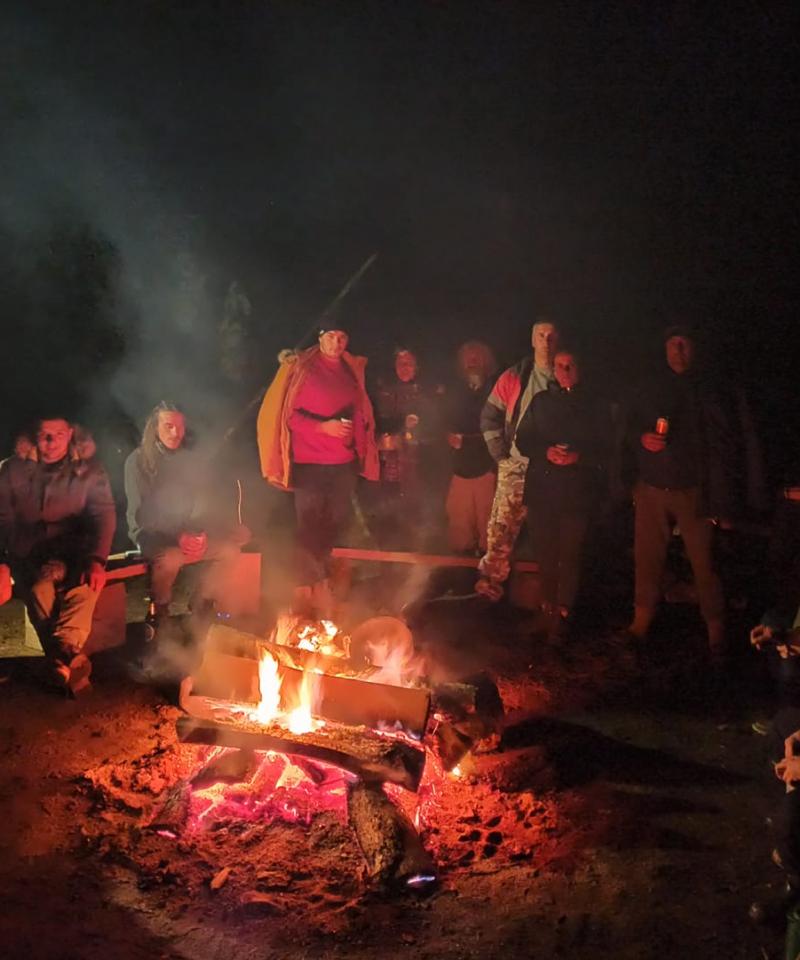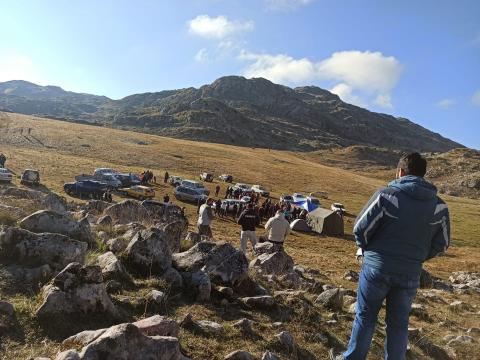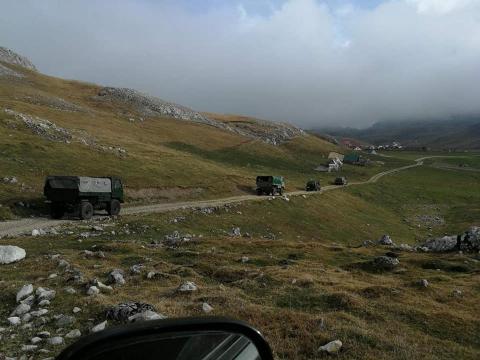Demilitarizing territories of life: an example from Sinjajevina, Montenegro

In September 2019 the government in Montenegro passed a decree inaugurating an artillery training ground on the grasslands of the Sinjajevina highlands, a rather karstic plateau with mostly smooth grassy slopes till the eye can reach in the north of Montenegro. and though the Ministry of Agriculture and Rural Development of Montenegro and the Ministry of Tourism and Sustainable Development initially opposed the military use of the land, higher ranks in the government seem to have played their role and silenced them. If a military training ground is consolidated in the area it would be very harmful to both local people in terms of their health, their economies, their livelihoods and their culture. It would also have a huge impact on grazing animals, the wild plants and animals, beekeeping, watercourses, agro-economy of the villagers, and ecology in general.
The first international NATO military training and weapon testing with important NATO allied forces from the USA, Italy, Austria and Slovenia began on 27th September 2019. Even if the local people and their grazing animals were still in the area, they were not really consulted regarding this project. It took place without any publicly available assessment on environmental, health or economic impacts of the military activities on this mountainous area, which has both rich biodiversity and cultural values. The European Union said nothing about what was occurring, despite Montenegro being a candidate state and probably one day a full member of the EU.
Sinjajevina is the greatest pastureland in the Balkan region and one of the biggest on the European continent, with a legacy of sustainable and biologically enriching pastoralist management of the land spanning thousands of years. It is a part of the great UNESCO biosphere reserve and is bordered by two UNESCO World Heritage sites. Over 22,000 people live in Sinjajevina’s lower lands today, and more than 250 pastoralist families use its highland pasture and their livelihoods are directly reliant on the land.
As rumors started to spread about another military training planned to take place from mid-October until the beginning of December 2020, a group of pastoralists, local people and people from other cities all around the country, different environmental activists and rights’ groups, began organising a protest. The construction of the military training ground would mean the destruction of a millenia-old relationship between humans and the environment, both materially and in terms of meaning, and therefore the destruction of a uniquely valuable bio-cultural system.
The military escalated warnings, and an official statement on 10th October announced that on Monday 19th October a military training exercise would begin on Sinjajevina. This pushed local pastoralists into action in collaboration with environmental activists and rights’ groups from all over Montenegro. Under the ‘Save Sinjajevina’ banner, a group of 150 people travelled to the pasturelands in Sinjajevina and set up, on Friday 16th October, a community blockade, backed up by an increasing number of international actors that supported the campaign. The group ended up setting up a permanent camp at Margita, a flat area the heart of the military training ground, where the protestors prepared to face the body of NATO soldiers that had started to arrive in the neighbouring city of Kolasin.
Initially, the aim of the protestors was to maintain their blockade until a new Montenegrin Government - who won a national election on the 30th August and were more sympathetic to Sinjajevina’s plight - was installed. The new government was originally expected to be formed by early November but finally did not come into place until 2nd December. This critical delay triggered a two-month long game of cat and mouse between herders and the military, during which the struggle for Sinjajevina made headlines across Montenegro and abroad.
The different groups of defenders had to remain very alert to military incursions into different parts of Sinjajevina. On the 18th of November, several groups of defenders took up positions on multiple hilltops around a newly established one-night military camp composed of around 100 troops. In that way, protesters, working as human shields, blocked any bombings into this new spot of the pasturelands some 3km away from the original protest camp in Margita.
On November 19, an army detachment also approached Okrugljak, the biggest katun (small settlements of mountain huts used by herder families) in Sinjajevina with over 15 active herder households 10km from Margita. Local people called for support and after a few hours of observation by defenders who again placed themselves as widely as possible over the top hills of the area, the army left, unable to find the “right” conditions for their weapon testing.
In tandem with the frontline measures taken by Save Sinjajevina defenders, allies of the herders were making their plight known across Montenegro and globally through the media. Some 100 organizations under the leadership of Land Rights Now, ICCA Consortium, International Land Coalition, the Common Lands Network and Rights & Resources signed a joint statement. They also launched a signature collection campaign with the support of Avaaz, and a crowdfunding request, to try to contribute to stopping the military in their attempt to occupy the pasturelands.
After this resistance locally and a combined national campaign and international campaign to support the protection of Sinjajevina’s social and ecological systems, the new Defense Minister of the recently elected government (which ended 30 years of rule of the Democratic Party of Socialists), announced that the plan for a military training ground on Sinjajevina would be revaluated. Protestors could go back to their homes because there was not going to be any more military trainings in the area that winter. However, there has been no official announcement cancelling the inauguration of the military polygon.
Some history...
In June 2017 Montenegro abandoned the policy of military neutrality and officially joined NATO as a member state, in an effort to align itself with Western powers, strengthen its links to the European Union and to grow westwards, while trying to make a clearer cut from its sister nation, Serbia. This break was led by Milo Djukanovic, the longtime leader of the country who is still today president, after 30 years at the top of the country from the moment of the end of Socialist Yugoslavia. Djukanovic joined the Yugoslav Communist League (SKJ) - the only political party allowed by law in the Yugoslavian one-party political system at the time - in 1979. By 1986, he was a presidency member of the Socialist Youth Alliance, and is one of two European post-socialist leaders - alongside Lukasenko in Belarus - to remain in power since the fall of the Berlin wall.
Djukanovic turned against Milošević in 1996, and also started abandoning the traditional Serbian-Montenegrin ethnic and cultural bond, ultimately pushing Montenegro to independence in a referendum in 2006. Djukanovic had a well thought out plan for his country as well as himself; after 30 years he is still the president of the country owning immense fortunes while the country’s mean salary is around €500 a month. Over the course of his several premierships and presidencies, Djukanovic eagerly bought into the neoliberal agenda of the west, and undertook massive privatization of the country’s public companies. He offered easy terms of ownership and engagement to foreign investors and firms from whom he and his close allies never ceased to benefit. Djukanovic’s rule has been marked by a high degree of autocracy leading to allegations of personal profiteering, which has provoked a series of peaceful protests over the last decade. Moreover, an Italian tribunal accused Djukanovic of collaborating with the mafia, a case that had to be dismissed when he acquired immunity due to his status as the head of the state.
In such context and after centuries of brotherhood with Serbia and long-held opposition to NATOs bombing of the ex-Yugoslav republic, Montenegrin society was very polarized when the ruling Democratic Party of Socialists (DPS) led by Djukanovic took the country into the NATO Alliance, without even holding a referendum. Then, just one year later, in March 2018 the first unofficial news about the plans for a military training ground reached the local communities in Sinjajevina and on September 5 2019, the Government decreed unilaterally the creation of the military training site in Sinjajevina.
The push for a Sinjajevina training ground does not seem to be driven by Montenegro’s army alone or even led by itself at all, as at full muster it comprises fewer than 2,400 active soldiers and seems to have no need for such a large scale military ground, especially with others in place already. The training ground was initially proposed at the size of 25,000 ha, almost three times the size of Paris, before being redued to 10,000 ha, then 7,500 ha, then back to 10,000 ha. Embarrassingly enough nobody really knows its size or limits, despite having already been inaugurated!
It seems very plausible that Montenegro’s and Sinjajevina’s position on Europe’s southeastern flank, at the very frontier of Russian and Western influences, is seen as strategic by NATO, and perhaps the European Union, of which Montenegro is not yet a member but a candidate, and which puts it in a position that makes Montenegro more vulnerable to pressure. It can’t be a coincidence that just one year after joining NATO, Montenegro decides to disposess people of their land, or that the NATO secretary general, Jens Stoltenberg, insisted publicly that military exercises must be carried out in Montenegro and that if NATO members want to remain members they must accept the presence of NATO and its military needs... which all in all makes one think that NATO really wanted this territory, which is clearly of geostrategic importance to NATO.
What might happen next
As there is now a new government in place and social and political majority in the country against the idea that Sinjajevina pastureland becomes a military ground and a growing national and international contestation is rising, there are rumors that the old plan of creating a top-down protected area in the region could come back in place.
Concerning this possibility, the Save Sinjajevina movement thinks that Sinjajevina should neither become a top-down nature park restrictive with traditional uses. Instead, it should be a horizontal, co-governed area promoting the economic activity of its pastoralist populations who, through their traditional herding practices, are the main guarantors of the construction and conservation of these ecosystems and unique landscapes. Without pastoralists there are no pastures in these subalpine contexts. Anybody with knowledge of Mediterranean mountain pasturleands can tell you, and the local farmers first, that if the pastoralism ceases, within 20 to 60 years the trees and forest start to arrive, and the rich and unique pastoral biodiversity there developed through thousands of year of co-adaptation between pastoralism and pastures would disappear.
So to conserve that nature you need to conserve the way that human activity has been in the area for millennia. Therefore, the Save Sinjajevina movement supports the idea of creating what we could call a ‘community protected area’, a Protected Area designed and governed with the full participation of local communities. In Sinjajevina humans should be actively interconnected with the environment, instead of being separated from it. The movement is critical of the old school concept of top-down management, where state institutions define what and how things should be done in the territory and ecosystems that have been managed by and for local communities for millennia. Therefore, things should move, at local, national and international level, or at least an important part of the struggle, in favor of granting a system where local communities actively participate in the decision making and management of Sinjajevina following the examples of other cases of success in the EU (see the same type of examples of the Dolomites in Italy or in the Cevennes in France).
How you can help
To support the campaign, people can:
- sign the international petition against the creation of the military ground on Sinjajevina and for the creation of a community conserved area, on the Land Rights Now web page (https://www.landrightsnow.org/get-involved/save-sinjajevina-now/
- contribute to the international crowdfunding that has been set up to help these fellows and local communities continue organizing to grant protection to their lands and livelihoods at the kukumiku website (https://www.kukumiku.com/proyectos/save-sinjajevina/)
- visit the Save Sinjajevina mouvement’s website in English at www.sinajevina.org, share this news with people and organizations interested in human rights, land rights issues and environmental protection, as they need all the help in the world.


Add new comment